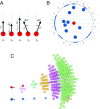Intrinsically motivated collective motion
- PMID: 31315977
- PMCID: PMC6681759
- DOI: 10.1073/pnas.1822069116
Intrinsically motivated collective motion
Abstract
Collective motion is found in various animal systems, active suspensions, and robotic or virtual agents. This is often understood by using high-level models that directly encode selected empirical features, such as coalignment and cohesion. Can these features be shown to emerge from an underlying, low-level principle? We find that they emerge naturally under future state maximization (FSM). Here, agents perceive a visual representation of the world around them, such as might be recorded on a simple retina, and then move to maximize the number of different visual environments that they expect to be able to access in the future. Such a control principle may confer evolutionary fitness in an uncertain world by enabling agents to deal with a wide variety of future scenarios. The collective dynamics that spontaneously emerge under FSM resemble animal systems in several qualitative aspects, including cohesion, coalignment, and collision suppression, none of which are explicitly encoded in the model. A multilayered neural network trained on simulated trajectories is shown to represent a heuristic mimicking FSM. Similar levels of reasoning would seem to be accessible under animal cognition, demonstrating a possible route to the emergence of collective motion in social animals directly from the control principle underlying FSM. Such models may also be good candidates for encoding into possible future realizations of artificial "intelligent" matter, able to sense light, process information, and move.
Keywords: active matter; collective motion; intelligent matter.
Conflict of interest statement
The authors declare no conflict of interest.
Figures





References
-
- Valadares L. F., et al. , Catalytic nanomotors: Self-propelled sphere dimers. Small 6, 565–572 (2010). - PubMed
-
- Palacci J., Sacanna S., Steinberg A. P., Pine D. J, Chaikin P. M., Living crystals of light-activated colloidal surfers. Science 339, 936–940 (2013). - PubMed
-
- Ramaswamy S., Active matter. J. Stat. Mech. Theory Exp. 2017, 054002 (2017).
-
- Cates M. E., Tailleur J., When are active Brownian particles and run-and-tumble particles equivalent? Consequences for motility-induced phase separation. EPL (Europhys. Lett.) 101 20010 (2013).
-
- Chaté H., Ginelli F., Relevance of metric-free interactions in flocking phenomena. Phys. Rev. Lett. 105, 168103 (2010). - PubMed
Publication types
MeSH terms
LinkOut - more resources
Full Text Sources

